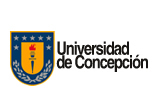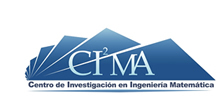News
Research by Fernando Peña was directed by Manuel Solano
- UdeC graduate contributed to the formuation of methods for the heat equation in curved domains.
An HDG method for the heat equation in curved domains is the name of the undergraduate thesis developed by Fernando Peña Villalobos and its successful defense granted him the title of Mathematical Civil Engineer from Universidad de Concepción, UdeC. In his work, he analyzed “a hybridizable discontinuous Galerkin scheme (HDG) for this equation” and among the main results, “we demonstrated that the proposed scheme is wellposed and we proved optimal error estimates for the heat distribution and its gradient. Moreover, we provided numerical experiments validating the theory”.

Dr. Manuel Solano Palma, Professor at the Department of Mathematical Engineering at the UdeC and researcher at the Center for Research in Mathematical Engineering, CI²MA, directed Fernando’s research work. “He is a very hardworking person who wants to be successful in his career and that is very important", emphasizes Solano, who, in the context of his PhD studies in the United States, began to develop the techniques that he transferred to Fernando for his research. Although the amount of time for an undergraduate thesis is much less than that of a Ph.D. work, in this case, explains Solano, “a complex problem related to the heat equation was addressed using an HDG method, and Fernando progressed quite well in the theoretical part. In the computational part he required a little more support but ended up programming the proposed method. On the other hand, Fernando did an intership IDEClab, where he is now working permanently, and I have heard very good comments about his performance as a data analyst”, highlights Solano, who supported Fernando through the incentive to undergraduate theses of his Fondecyt project. “The heat equation”, Solano explains, “models the heat distribution of a body. So, by solving it, we can obtain the value of the temperature of an object at a certain point on a specific time”.
Among the main contributions of the research conducted by Fernando, is the fact that it is the first time that the techniques developed by Solano are applied to evolutionary problems. “Until now, we had only worked on steady state models, without considering the time variable. We are interested in solving increasingly complex problems and this is an excellent first step, although it does not yet have a direct application”. In this direction and regarding to the potential lines of research that could be followed from the results of his study, Peña explains that “other equations could be investigated on non-stationary problems such as the wave equation, or any other that involves the temporal variable”. One of the members of the exam evaluation committee was the researcher of the New York University, Dr. Tonatiuh Sánchez-Vizuet who has collaborated with Professor Solano during the last years. “We have written three papers together and we are in the process of writing a fourth”, Sánchez-Vizuet explains and, regarding the contents of his interest that are addressed in Fernando's work, the researcher details that “he uses a technique to approximate solutions to partial differential equations raised in domains whit curved borders. The technique was developed by Manuel Solano and has been adopted by some other researchers, including myself. Furthermore, the thesis work combines this technique with the use of the HDG method, which is also one of the methods continuously used in my work”.
Among other results of the collaboration between the two scientists is the internship that Solano's Ph.D. student, Néstor Sánchez, carried out at NYU in 2019. “There are different problems that can be addressed with these techniques, but they have in common that they are methods for geometry that are not polygonal”, he explains. “I chose Tonatiuh because he knows the techniques, so the questions he would ask in the defense would be appropriate. And the other committee member was Paulo Zúñiga, who was one of my doctoral students, working on the same technique but applied to mixed finite element methods for steady-state problems”, he details. Fernando highlights that “as a mathematical engineer, I finish my degree with a solid programming and engineering base in general, which makes it easier for me to find a job because, as we know, all companies and organizations are experiencing a stage of digitization of their processes. A mathematician can quickly adapt to a specific work environment, understanding the problems of the organization, separating the processes to reach the organizational objectives. The programming base that Professor Solano gave me enables me to face complex processes”. In the same way, Professor Sánchez-Vizuet emphasizes that “the graduates of the CI²MA numerical analysis group have a very solid training and research experience that make them very strong candidates to undertake doctoral studies at foreign universities. There are an increasing number of graduates from CI²MA who are performing satisfactorily as students in the United States and Europe”.
Regarding his professional future, Fernando explains that “currently, I am working at IDEClab of UdeC, which seeks to promote educational innovation, and we are analyzing the basic courses of Physics, Chemistry, Biology and Mathematics, based on the data generated by the Canvas platform, in terms of more active users and more used resources. Then, we will apply machine learning tools and, later, we will extend these analyzes to all the University courses”, he details.

